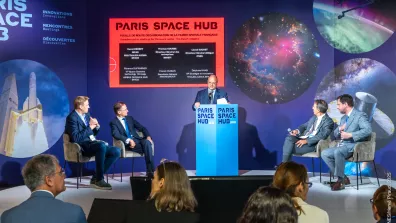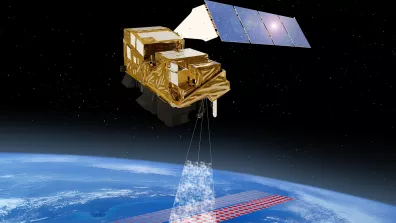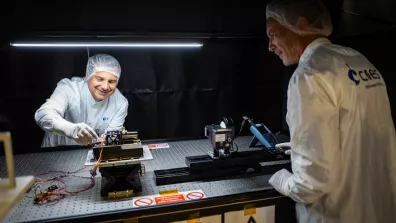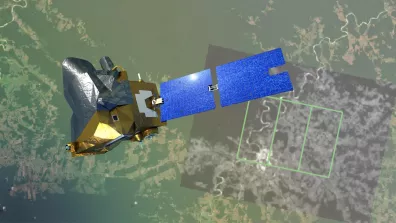Accelerating climate change is pushing societies everywhere to find ways of curbing their carbon footprint. In France, the Climate and Resilience Act notably obliges the main greenhouse-gas-emitting industries to establish decarbonization strategies, in line with the National low-carbon strategy, which has set the goal of becoming carbon neutral by 2050. This will require balancing carbon emissions and absorption or offset mechanisms to reach net zero.
Since 2023, under the impetus of the Ministry of the Economy, the space sector has risen to this challenge. Working through the CoSpace government-industry space coordination committee, space stakeholders have established a decarbonization roadmap, unveiled at this year’s Paris Air Show.
The roadmap is a team effort led by CNES to ensure that space bears its fair share of efforts to decarbonize French industry. France is the first space nation to make this kind of voluntary commitment.
- CNES Sustainable Development Officer

Identifying pollution sources
The first phase of this approach consists in establishing the carbon footprint of space activities. This sector-wide assessment covers both launchers and launch activities, as well as satellites and all downstream activities, including users of space solutions, plus generation and storage of the vast volumes of data derived from space. It gives a detailed and objective picture that confirms space’s moderate carbon impacts (approximately 0.3% of all carbon emissions in France), debunking a number of myths in the process.
For example, you might think that launches account for most of space’s carbon footprint—in fact, you would be wrong. Satellites and associated ground support equipment and space facilities, along with data management and processing, all contribute significantly. This can be explained by the relatively low number of European launches, while the development of space over the last decade has been fuelled more by users hungry for services underpinned by space in their daily lives.
Near-ubiquitous satellite connectivity is multiplying the number of ground terminals, which is where most pollution today is coming from. But planned increased launch cadences in Europe, following a similar trend to the United States, could be a game changer. There are also uncertainties, for example about the impacts of space activities on the upper atmosphere, which we haven’t yet quantified precisely and call for more research.
- Space regulation and sustainability project leader at DGE, the French enterprise agency

Eleven levers
Working from this assessment, the working group identified five main focuses, associated with 11 levers for curbing space’s carbon footprint. The decarbonization roadmap thus opens up avenues for cutting energy consumption across all phases of development, qualification and manufacturing.
The roadmap also underlines the need to optimize transportation and supply chain logistics, to work on materials and industrial processes to foster eco-design, and to eliminate duplication of industrial tools and infrastructures. Data storage, processing and accessibility are another priority.
We’ve now entered a new phase where private and public stakeholders alike must align their strategic and operational decisions with this path. For example, the roadmap will be a key element when choosing whether to devote government support and funding to space programmes. A dashboard-type mechanism will enable firms to track their commitments and report on them voluntarily.
Sobriety and innovation
Looking beyond the environmental urgency, the challenge of decarbonization spans innovation, economic competiveness and sovereignty. The roadmap also offers the space ecosystem the opportunity to reinvent processes, inject new impetus into research and development to foster disruptive technologies, and guard against volatility in energy prices or difficulties obtaining raw materials.
Industry has grasped the nettle. New space service providers are also addressing these ecological transition concerns, for example envisioning construction of common launch pads to accommodate different launchers. The fact they’re taking the issue on board shows the maturity of French industry and is vital for the sector to stay ahead of the curve. CNES is playing a key role leading this approach through its science and engineering expertise and by maintaining constant dialogue with contractors.
The decarbonization roadmap also marks a starting point and an incentive for companies and research centres to work on innovation projects geared towards curbing the impacts of space systems throughout their life cycle.
Given the unknowns regarding the sector’s future, this trajectory will need to be regularly reviewed, in particular from a European perspective: programmatic decisions made by the European Space Agency (ESA) and European Union regulations must also factor in these evolutions.
One thing is sure: there can be no letting up on these efforts, concludes Laurence Monnoyer-Smith. “The levers currently identified don’t yet enable us to achieve the objective of becoming carbon neutral by 2050. We must pursue our sobriety and innovation efforts, and make choices to sustain our industry’s competitiveness and sovereignty, while staying within environmental constraints.”
Space addressing climate challenges
While space activities may have carbon impacts, they nevertheless provide precious services in combating climate change and driving the ecological transition. Like the MicroCarb satellite launched last summer to measure CO2 concentrations or Europe’s Copernicus programme, major Earth-observation missions are delivering key insights into environmental phenomena. Of the 50 essential climate variables identified by the IPCC, 26 can only be measured from space. Space technologies are also playing a pivotal role in developing climate resilience and seeking solutions to mitigate the effects of climate change.





